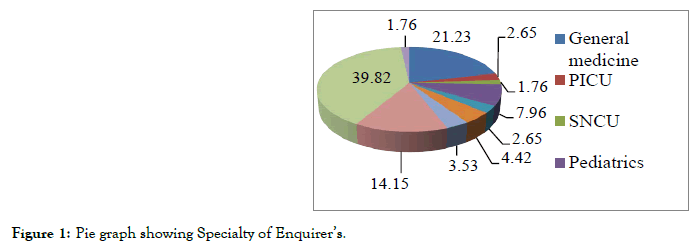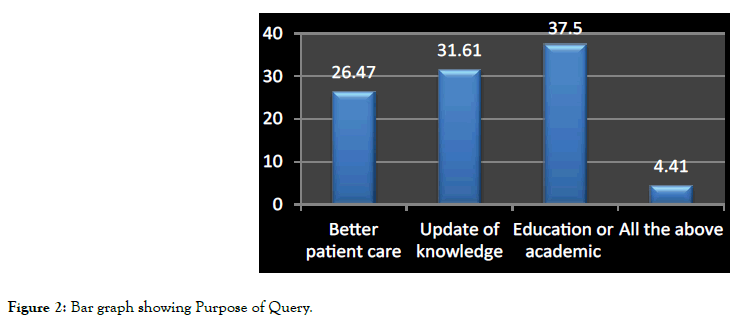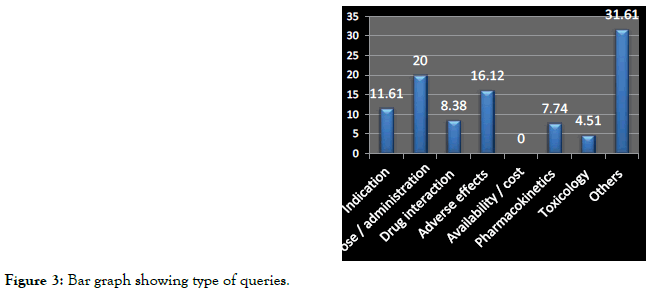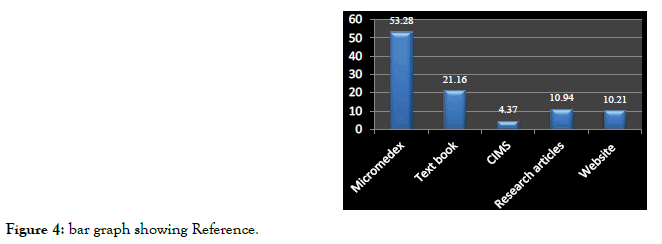Indexed In
- Open J Gate
- JournalTOCs
- The Global Impact Factor (GIF)
- RefSeek
- Hamdard University
- EBSCO A-Z
- OCLC- WorldCat
- Publons
- Euro Pub
- Google Scholar
Useful Links
Share This Page
Journal Flyer

Open Access Journals
- Agri and Aquaculture
- Biochemistry
- Bioinformatics & Systems Biology
- Business & Management
- Chemistry
- Clinical Sciences
- Engineering
- Food & Nutrition
- General Science
- Genetics & Molecular Biology
- Immunology & Microbiology
- Medical Sciences
- Neuroscience & Psychology
- Nursing & Health Care
- Pharmaceutical Sciences
Research - (2020) Volume 8, Issue 3
Assessment and evaluation of drug information services provided by department of pharmacy practice based on enquirer’s perspective at tertiary care hospital, Kalburgi
Boyapally Sunil Kumar*, Sodabattula Manjusha and Vishwanath JeevangiReceived: 15-Jun-2020 Published: 27-Jul-2020, DOI: 10.35248/2329-6887.20.8.280
Abstract
Background: Drug-information service (DIS), is still in a nascent stage, and might be due to late introduction of such tradition in India. It is an undervalued course of department of pharmacy practice that is barely used to their full potential in providing information about drug to the health-care professionals in India. This study has been conducted to expound and explore the information regarding drug needed to enquirer mainly patient specific. The service comprises of collecting, reviewing, evaluating, indexing, and distributing information requested by enquirer. Rational drug use demands access to unbiased drug-information.
Aim: To assess and evaluate the DIS provided by department of pharmacy practice based on enquirer’s perspective.
Materials and methods: A hospital based prospective study for six months was conducted.
Results: A total of 113 queries were received with an average of 18.83 queries per month. Majority of queries were received from interns (39.82%) and general medicine physicians (21.23%). Predominantly asked for the purpose of education or academic 51(37.50%), update of knowledge 31(31.61%) and better patient care 36(26.47%). The feedbacks of the response were rated as ‟good and satisfactory”.
Conclusion: The quality of the services provided by the center suggests providing more awareness regarding DIS.
Keywords
Drug Information Centre; Drug Information Service; Pharmacist; Enquirer’s perspective
Introduction
Drug Information Services (DIS) encompasses the activities of specially trained individuals to provide accurate, unbiased, and factual information primarily given in response to patient-oriented drug problems received from pharmacists, nurses, clinicians, and other healthcare professionals [1]. Drug information service is a specialized service provided by pharmacists to enhance drug knowledge, empower rational prescribing, and reduce medication errors [2]. Drug information (DI) is provided on various aspects of drug therapy, which includes information related to administration and dosage, ADR, drug interaction, drug therapy, cost, and availability. Information required may be either general information on drugs or patient specific information for a clinical situation [3]. Information is the key to practice evidence-based medicine. Such information leads to enhanced quality of patient care and thus improve patient outcome. Poor drug regulation and lack of independent, unbiased DI are some of the contributing reasons for irrational drug use in India. About 40% of the health care services budget is consumed by medicines and with a limited resource available, it is essential to promote rational drug use [4]. Drug information service describes activities undertaken by pharmacists in providing information to optimize drug use. The goal of clinical pharmacist involvement in the provision of drug information is to contribute to patient care and to optimize drug therapy. Clinical pharmacist involvement will help clinicians to understand about new drugs for which little information is available [5].
Drug information is the provision of written and/or verbal information about drugs and drug therapy in response to a request from other healthcare providing organizations, committees, patients, and public community. Drug information center (DIC) provides in-depth, unbiased source of crucial drug information to meet needs of the practicing physicians, pharmacists, and other health care professionals [6]. Most developing countries suffer from lack of adequate drug information due to limited availability of current literature and also poor documentation and dissemination of what little information is available. Existence and proper functioning of independent drug information centres can greatly contribute to the provision of unbiased drug information that is much needed in these countries. A teaching hospital-based drug information centre can be of assistance not only in-patient care but also in educational activities. The Centre can benefit from the material, monetary and multidisciplinary human resources that are usually available in such an institution [7]. In Indian scenario, general practitioner may not have access to reference books or computer-based databases like their counterparts in developed countries. In India, physicians receive most of their information from pharmaceutical company representatives. In hospital settings where DICs functions, drug information need of physicians may be met. The number of drugs approved by FDA has increased dramatically in recent years. The average approval per year was 13.7 New Chemical Entities (NCEs) in sixties to 53 in nineties. When biological products and new dosage forms were added around 140 products were approved in a year [8]. At this rate of approval and new drug entry into market, it is difficult for any medical professional to keep abreast with new developments. Information seeking behavior of physicians is a subject of research in age of information explosion. Physicians seek information regarding various issues in medical care especially drug information. Physicians use colleagues’ and consultants’ help, drug compendia, bound journals or computer based resources for their reference [9]. Moreover, due to information explosion, vast availability of literature and lack of time; health care professionals are not in a position to update their knowledge. Though there are prescription and non-prescription drugs; the free availability of drugs, irrational drug use, iatrogenic diseases, antibiotic resistance, adverse drug reactions and events are very common in India. Drug information centers (DICs) provide information mainly to healthcare professionals and general public with information about all aspects of drug. Clinical pharmacist involvement will help clinicians to understand about new drugs for which there is increasing demand for independent, unbiased information about new drugs for a better patient care [10].
Methodology
Study design: Hospital based Prospective study.
Prospective study: A study design which seeks to assess the association between a hypothesized risk factor and an illness by sampling both exposed and unexposed subjects (or intervention and non- intervention groups) and then following them for the period of study.
E.g.: concurrent cohort studies, randomized controlled trials
Study site: Drug information center at Gulbarga institute of medical sciences, Kalaburagi.
Study duration: 6 Months of study was conducted from September 2018 to March 2019
Inclusion criteria:
1. Drug information enquiries from health care professionals.
2. Drug information enquiries from patients of tertiary care hospital.
Exclusion criteria: Drug information enquiries from others (outside health care professionals and patients).
Source of data: The data will be collected from Drug information Centre through
1. Drug information request forms.
2. Feedback questionnaires form.
Study procedure
The study procedure included 2 steps. In that the first step in the evaluation of DISs involved assessment of drug information request and documentation forms prospectively for a period of six months, from September 2018 to March 2019, for various benchmarks like status of the enquirer, Specialty of practice, mode of receipt of query, category of question, purpose of enquiry, timeframe to reply and references used.
The second step involved assessment of the quality of services provided from the enquirer’s perspective on the basis of the feedback questionnaire disseminated, which encompassed of questions concerning to perception, utilization, ease of contact and quality of service disclosed by the DIC. Suggestions from the enquirer on the DIC were also heeded. The filled questionnaires were collected on the same day from individual respondents.
Various references were used to answer each query. Most of them were answered by using Micromedex 73 (53.28%) Other reference sources was text book (pharmacotherapy Dipiro 7th Ed , Roger Walker Clinical Pharmacy and Therapeutics 5th Ed etc.) 29 (21.16%) ,various articles 15 (10.94%) and website (like www.fda. gov.in& etc.) 14 (10.21%).
Results
Number of Queries Collected Month Wise:
A total number of 113 queries received till now during the study period in pharmacy practice department at tertiary care hospital.
• Sep 15 – Oct 14(19 queries); Oct 15 – Nov 14(17 queries); Nov 15 – Dec 14(23 queries); Dec 15 – Jan 14(16 queries); Jan 15 – Feb 14 (16 queries); Feb 15 – Mar 15 (20 queries).
• In an average we received 18.83 queries per month.
Specialty of Enquirer’s:
Based on the type of Specialty of enquirer’s we categorized them into following i.e., General medicine, PICU, SNCU, Pediatrics, General surgery, Chest & TB, Orthopedic, Dermatology, Interns, Others (nurses & department of pharmacy). (Table 1, Figure 1)
| S.No | Specialty of enquirer | No. of queries | Percentage (%) |
|---|---|---|---|
| 1 | General medicine | 24 | 21.23 |
| 2 | PICU | 03 | 2.65 |
| 3 | SNCU | 02 | 1.76 |
| 4 | Pediatrics | 09 | 7.96 |
| 5 | General surgery | 03 | 2.65 |
| 6 | Chest & TB | 05 | 4.42 |
| 7 | Orthopedic | 04 | 3.53 |
| 8 | Dermatology | 16 | 14.15 |
| 9 | Interns | 45 | 39.82 |
| 10 | Others | 02 | 1.76 |
Table 1: Specialty of Enquirer’s.

Figure 1. Pie graph showing Specialty of Enquirer’s.
Mode of Request:
Here we included 3 mode of request in our study I.e. Direct access, during ward round &Telephone where 84 (74.33%) queries was through direct access, 23 (20.35%) queries during ward round and 06 (5.30%) queries through telephone.
Purpose of Query:
Out of 113 queries more number of queries were for Education or academic 51(37.50), Update of knowledge 31(31.61) and Better patient care 36 (26.47). (Table 2, Figure 2)
| S.no | Purpose of query | No. of queries | Percentage (%) |
|---|---|---|---|
| 1. | Better patient care | 36 | 26.47 |
| 2. | Update of knowledge | 43 | 31.61 |
| 3. | Education or academic | 51 | 37.50 |
| 4. | All the above | 06 | 4.41 |
Table 2: Purpose of Query:

Figure 2. Bar graph showing Purpose of Query.
Response Needed:
Out of 113 queries, the time period of Response needed was within a day was 69 (61.06%), within 1-2 days 30 (26.54%) & immediately 14 (12.38%).
Mode of Reply:
Most of the queries we collected were answered through printed form i.e. 101 (89.38%) followed by verbal 7(6.19%) and written 5(4.42%).
Type of Queries: (Table 3, Figure 3)
Various references were used to answer each query. Most of them were answered by using Micromedex 73 (53.28%) Other reference sources was text book (pharmacotherapy Dipiro 7th Ed , Roger Walker Clinical Pharmacy and Therapeutics 5th Ed etc.) 29 (21.16%) ,various articles 15 (10.94%) and website 14 (10.21%) (Figure 4)
| S.no | Type of queries | No. of queries | Percentage (%) |
|---|---|---|---|
| 1 | Indication | 18 | 11.61 |
| 2 | Dose / administration | 31 | 20.0 |
| 3 | Drug interaction | 13 | 8.38 |
| 4 | Adverse effects | 25 | 16.12 |
| 5 | Availability / cost | 0 | 00 |
| 6 | Pharmacokinetics | 12 | 7.74 |
| 7 | Toxicology | 07 | 4.51 |
| 8 | Others | 49 | 31.61 |
Table 3: Type of Queries.

Figure 3. Bar graph showing type of queries.

Figure 4. bar graph showing Reference.
Discussion
The study was conducted for a period of 6months. During this we used to go to ward rounds for daily basis and request of queries if any from the health care professionals.
A total number of 113 queries received by us during our study period. On an average we received 18.83queriesper month. After analyzing the study, a great percentage of the queries was from interns (39.82%) followed by General Medicine department (21.23%). DIS was utilized by interns and physicians to a greater extent compared to pharmacists, postgraduates, nurses, and other healthcare professionals. Most of queries were asked for education/academic purpose (37.50%), update of knowledge (31.61%), better patient care (26.47%) and all the above (4.41%). The time period of response needed for received queries was within a day (61.06%) followed by within 1-2 days (26.54%) and immediately (12.38%).
According to categorization of the received queries most number of queries were about others like contraindications, patient counseling, mechanism of action, side effects etc., was (31.61%) followed by dose/administration (20%), adverse effects (16.12%), indications (9.61%), drug interactions (8.38%), pharmacokinetics (7.74%) and toxicology (4.51%).
In our study the main descent of reply was taken from secondary resources in particular Micromedex. This might be because of ready availability of Micromedex (computerized drug information database) and the liberation of getting answers make Micromedex an autonomous reference resource. Rest of them were tertiary resources such as textbooks and websites.
Most of the enquirers utilized the DIS regularly and appreciated the quality of services provided by us and, physicians suggested that still more awareness is required regarding DIC. A few suggestions propounded to improve the performance of the center were provision of a 24-hour service and increasing the interaction of clinical pharmacists and other healthcare professions.
The feedback questionnaires were analyzed and feedbacks of the response are rated as “good‟, and “satisfactory‟.
Conclusion
DIS were well utilized by the physicians and other health care professionals and the DIC has been contributing towards better patient care by helping and assisting the health care professionals in optimizing the drug therapy by providing unbiased and relevant information for better patient care. However, improvement in answering the judgmental enquiries is required, especially on telephone. The results of the feedback questionnaire showed that most of the enquirers appreciated the quality of services provided and requested for a 24 hour round the clock service. With all these past performances it can be concluded that the center has maintained quality and in future more studies should be conducted to assess the improvement in the performance and more awareness of DIC.
Our article suggests that the quality of the services provided by the center was good and satisfactory & needed to improve. However, there is a lesser awareness about the service in the hospital and constant encouragement to healthcare professionals to utilize the services for better patient care. Using appropriate evidence-based DIC with shortest time with shortest modes of communication (phone) could establish a system of DI to improve practice of prescribers. An effective DIC service saves the time of practitioners. At present the DIC services were mostly used for academic interests. Interns used DIS for the highest compared to other health care professionals. As it is still in its budding stage much more resources and reforms must be developed in hospital setup.
REFERENCES
- George B, Rao PG. Assessment and evaluation of drug information services provided in a South Indian teaching hospital. Indian journal of pharmacology. 2005; 37(5),315-319.
- Alamri SA, Ali Al Jaizani R, Naqvi AA, Ghamdi MS. Assessment of drug information service in public and private sector tertiary care hospitals in the eastern province of Saudi Arabia. Pharmacy. 2017; 2-7
- Jimmy B, Jose J, Rao PG. Short communication: pattern of adverse drug reaction related queries received by the drug information centre of a tertiary care teaching hospital. Pak J Pharm Sci. 2007; 20(4):333-9.
- Bhavsar R, Zachariah S, Thomas D, Kannan SM. Evaluation and appraisal of drug information services in a rural secondary level care hospital, Anantapur, AP. Journal of pharmacy & bioallied sciences. 2012; 4(4):302.
- Dooley MJ, Bogovic A, Carroll ME, Cuell S, Galbraith KJ, Matthews H. SHPA standards of practice for clinical pharmacy. Journal of Pharmacy Practice and Research. 2005; 35(2):122-46.
- Chauhan N, Moin S, Pandey A, Mittal A, Bajaj U. Indian aspects of drug information resources and impact of drug information centre on community. Journal of Advanced Pharmaceutical Technology & Research. 2013; 4(2):84-93.
- Mohan JP. Drug information service at teaching hospitals in developing countries. Indian journal of pharmacology. 1998 Jan 1;30(1):1.
- Mallayasamy SR, Fayazkhan M, Kishore GS, Acharya LD, Rao PG. Evaluation of drug information service provided by clinical pharmacy department based on provider and enquirers' perspective. Indian Journal of Pharmacy Practice. 2008;1(1).
- Gorman P. Information needs in primary care: a survey of rural and nonrural primary care physicians. Medinfo. 2001 Sep;10(Pt 1):338-42.
- Parthasarathi G, Ramesh M, Nyfort-Hansen K, Nagavi BG. Clinical pharmacy in a South Indian teaching hospital. Annals of Pharmacotherapy. 2002 May;36(5):927-32.
Citation: Boyapally SK, Sodabattula M, Vishwanath J (2020) Assessment and evaluation of drug information services provided by department of pharmacy practice based on enquirer’s perspective at tertiary care hospital, Kalburgi. J. Pharamacovigil. 8:280. doi-10.35248/2329-6887.20.8.280.
Copyright: © 2020 Boyapally SK. This is an open-access article distributed under the terms of the Creative Commons Attribution License, which permits unrestricted use, distribution, and reproduction in any medium, provided the original author and source are credited.

